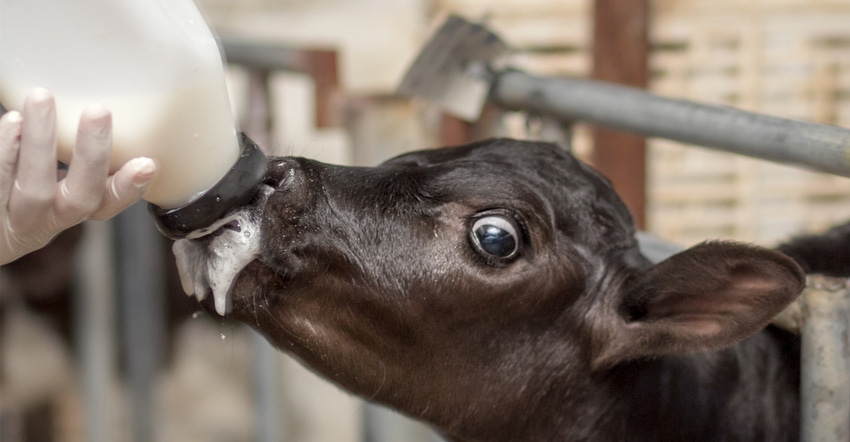December 20, 2022

Dairies using beef sires for breeding has created a robust dairy-beef wet calf market. Just how well are these wet calves handling transport, commingling and their new feeding facility? Those that receive adequate passive transfer of colostrum are more likely to survive and thrive.
The USDA National Animal Health Monitoring System Dairy 2014 survey found that on average, bull calves left U.S. dairy farms at 7 days of age. In the survey, 93% of the reporting farms indicated bull calves received colostrum, but of those, 1.5% received colostrum only by suckling the dam. No operations reported suckling as the sole means of providing colostrum to heifer calves. When bull calves were hand-fed colostrum, they received less volume, and they were fed colostrum later than heifers on the farm.
Coupled together, these contribute to failure of passive transfer for wet bull calves transported from dairy farms. Do similar disparagements occur on your farm between your dairy bulls and retained dairy heifers and now the dairy-beef-cross calves?
Colostrum inequities
Calves with failure of passive transfer (FPT) have a higher risk for developing disease, plus they shed more pathogens and contaminate calf-housing environments at higher rates than calves that receive adequate passive immunity. During transport, FPT calves shed pathogens in trailers and environments where they are off-loaded, which increases the risk of infection to all calves they contact. The stress of loading and unloading, more so than the total distance traveled, causes increased shedding of pathogens. FPT translates into higher morbidity and mortality rates among pre- and post-weaned calves.
Dairy-beef-cross calves will be on the grill in less than 20 months after birth. Feeder calves need to move on to high-energy rations to reach final weights in a timely manner. There is not enough time to recover from poor calf performance due to early calfhood diseases. Prevention of infectious scour and respiratory agents for calves under 4 months of age is best provided by passive transfer of colostrum. One or two treatments for respiratory symptoms early in a young calf’s life may cause reduced lung capacity, which raises susceptibility to respiratory disease later in life in the feedlot. That, in turn, leads to poor weight gain and reduced meat quality grades.
Marketing wet dairy-beef-cross calves with some guarantee of future health and growth performance is an opportunity no dairies should ignore. Market the wet calf’s health status by sharing evidence of passive transfer of colostrum and the dam’s vaccination protocol. The calf received colostrum; therefore, the calf should have maternal antibody to the agents covered by the dry cow or close-up heifer vaccine protocol that includes scour prevention vaccines. Also share the herd prevention strategies for bovine viral diarrhea virus.
Portable calf scale
Use a portable calf scale to measure the calf’s weight before colostrum feeding to determine colostrum and subsequent feeding accuracy. Weekly, validate colostrum management by measuring serum total protein or Brix measurements of all calves greater than 1 day but less than 7 days of age. Use serum monitoring to continuously improve your colostrum management.
Market calves with documentation of passive transfer and keep those with failing scores at home; don’t transport them, as they have more pathogen risk during transport and commingling than do your retained calves.
The impact from future disease challenges is reduced just by applying a very good colostrum program to every calf, including dairy-beef-cross calves. Do you have enough colostrum? What’s your plan to ensure every calf gets what it needs?
Stuttgen is a veterinarian and University of Wisconsin Extension agriculture educator for Taylor County. This column is provided by the UW Division of Extension Livestock Team.
You May Also Like




